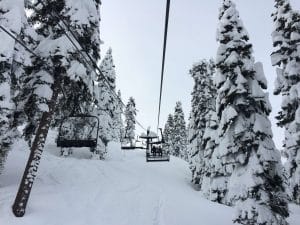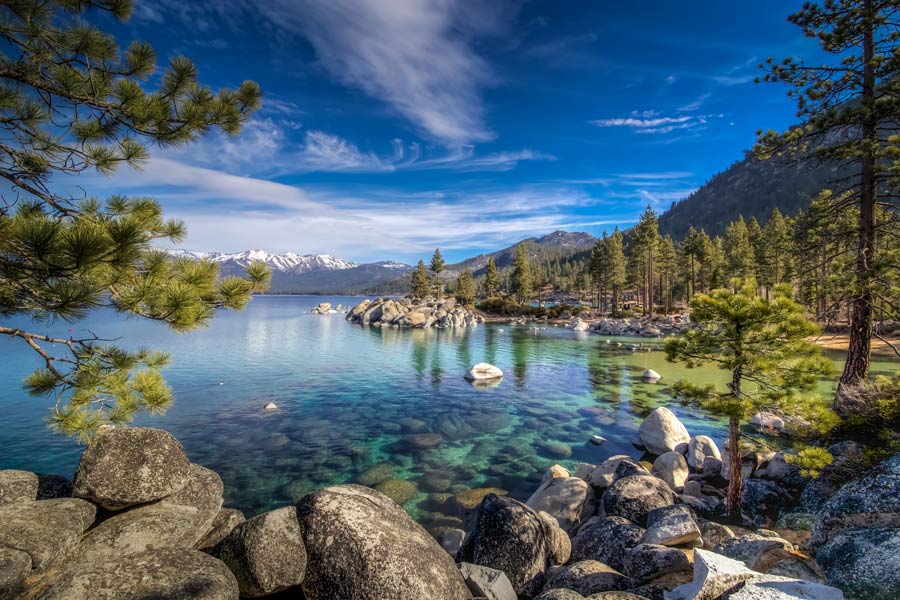The “Blob” is Back… Are Tahoe Skiers In For A Rough Winter?
Article written by: Alex Silgalis | Local Freshies® Original article published on localfreshies.com
I still remember the OG Blob—that 1958 sci-fi flick where an alien oozes its way across Earth, devouring everything in sight. And when meteorologists started using that name for a real weather pattern in the Pacific? Yeah… it was just as terrifying, at least for us snow lovers. The last time this beast showed up it was over the course of multiple seasons. Spoiler alert: it was a nightmare for Tahoe skiers and snowboarders. Now it’s back. Will it stick around? Too early to say. But let’s take a quick trip down memory lane and see what the original “Blob” winters looked like, and what it might mean for us this season. Huge thanks to Tony Crocker for allowing us to use his information to give us a glimpse at these past winters.
Beyond El Niño & La Niña – Meet “The Blob” We all know El Niño and La Niña can seriously mess with how much snow our favorite ski resorts get. But back in the summer of 2013, a new term slid into the ski weather lexicon: “The Blob.”
Meteorologists coined the term to describe a massive marine heatwave in the northeastern Pacific. This is when ocean water temps soared way above normal. A stubborn high-pressure system parked itself over the region, calming the surface winds. With weaker winds, there was less evaporation and mixing of deeper, cooler water — basically creating a hot tub effect in the ocean.
Battle of the Blobs – Who Won?
The first Blob hit during the 2013/14 and 2014/15 seasons, and then Blob 2.0 made an unwanted comeback in the summer of 2019, throwing a wrench into the 2019/20 and 2020/21 winters. As you can see in the chart below, some winters everyone got hosed. Others? Not as bad. You can read more about how each region in North America fared here.
How The Snow Arrived
While the total snowfall is important what matters more is HOW the snow arrived. Did ALL of it come in one month? Things like did the storms come in warm on a Pineapple Express or cold via an Alaska low? Let’s dive into what the storm patterns looked like specifically for all the blob seasons for Tahoe. If they provide any inkling expect a rollercoaster ride of weather.
2013/14 Ski Season
Snow levels told the real story of the winter—like at Palisades, where 263″ fell at 8,000 feet but only 90″ at the base. The season started dry, with just a brief tease in mid-January before finally turning on in late January through mid-February. The Sierra picked up 3–5 feet, and NorCal saw a decent rebound with March bookend storms.
2014/15 Ski Season
Out of all the infamous “Blob” seasons, this one took the crown as the worst yet. California, the Pacific Northwest, Utah, and the U.S. Northern Rockies all tied or broke snowfall records dating back to the brutal winter of ’76–’77. Even the “better” zones still clocked in below average.
Overview
Similar to 2013/14 winter it wasn’t just the lack of snow—it was the elevation rollercoaster. Storms often looked promising but came in warm, dumping rain below 8,000 feet and snow only up high. February’s biggest system turned into a washout for much of the region, and March brought almost nothing—some California resorts saw zero snow. Ironically, the most wintry weather hit in April and May, but by then, the lifts had mostly stopped spinning.
2019/20
The season started early with Mt. Rose spinning lifts by October 25 and Mammoth opening November 9. But the first Sierra snow did not arrive until November 20 and barely covered the ground. That changed fast. A huge Thanksgiving storm dropped feet, pushing Mammoth to full operations while lower elevations in Tahoe got rain, a trend that continued. February brought just 4 inches, making it the driest on record. Then came Miracle March in Tahoe and a full reset. Just when it seemed over, April delivered a final HUGE storm for a legendary late season sendoff.
2020/21
What stood out in Tahoe was the sharp north-to-south snowfall split. Palisades reached 76 percent of normal above 8000 feet, while Kirkwood hit just 58 percent. The season started slow. By Christmas, only half the terrain was open, and even by MLK weekend, advanced runs were limited with thin coverage, helped mostly by snowmaking. The big turnaround came in late January, when an atmospheric river dropped several feet, giving the season a much-needed boost. February brought about 2 feet, followed by warm storms with high snow levels that pushed many resorts into early spring conditions. March opened strong with around 3 feet, but the second half saw less than 2 feet. By early April, warm weather took over bringing spring skiing.
Visit https://localfreshies.com/blob-water/ to read the full article.

Support Local Journalism

Support Local Journalism
Readers around the Lake Tahoe Basin and beyond make the Tahoe Tribune's work possible. Your financial contribution supports our efforts to deliver quality, locally relevant journalism.
Now more than ever, your support is critical to help us keep our community informed about the evolving coronavirus pandemic and the impact it is having locally. Every contribution, however large or small, will make a difference.
Your donation will help us continue to cover COVID-19 and our other vital local news.










